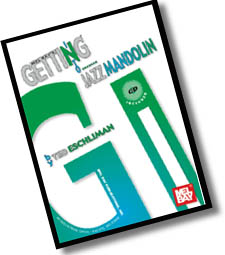« The Absynth Quintet: Indigo Shoes |
Main
| Eastman Giacomel coming to the JazzMando Lab »
 November 4, 2008 | GiJM Feedback November 4, 2008 | GiJM Feedback
We've enjoyed the communications we've received since the September release of "Getting Into Jazz Mandolin." Some include questions "Can you diagram the related 2nd octave fingerings on page 5 & 7?" for example, or typos captured (page 38, 2nd exercise meas. 7 the finger cue should be 1, not 4), or just a simple glimpse into how the book is impacting personal playing. The following comments are the recent reflections of C. Shoreman:
"I was pleased to receive your email comfirming my delivery of "Getting Into Jazz". I have enjoyed your articles on the Mel Bay site and your jazzmando site has expanded my insight into the possibilities of our hand held circle of fifths. I love how logical the instrument is. You are the first one to open up the patterns of the mandolin and fiddle for me. I thank you for that and was delighted to see that you have placed your ideas into a sequential format. I love the jazz standards and always thought that the genre was beyond mere mortal comprehension. My favourite artist is Leon Redbone and I would love to perform that sort of material on mandolin.
"I am currently play mandolin, fiddle and sing in a local Celtic group. I am a retired high school teacher and promised myself that I would devote myself to one of my instruments and become a true student. Your site and insight helped me to chose the mandolin. Thanks. Keep up the good fight."
We're pleased to see the book resonate with fiddlers. Also, experienced guitarists who desire more immediate insight into the secrets and layout of the mandolin fretboard are weighing in positively. Though the book has been conceptualized to gently introduce the folk mandolinist into a greater understanding of more complex harmonic possibilities, many experience musicians are finding some gems to move them more rapidly into mandolin "multi-instrumentalism" as well!
We'd like to continue to chronicle other reader's experiences with these materials. Ultimately, this is fodder for future articles, as well as the chance to better explain concepts that aren't quite hitting home yet. Chances are if you have a question, someone else on the globe has that same one.

More about the book: Getting Into Jazz Mandolin
Feedback: Contact Us
Enjoy the latest addition to our PROFESSIONAL'S SOUND LAB
Posted by Ted at November 4, 2008 5:38 AM

Disclaimer: In the 'Information Age' of the 21st Century,
any fool with a computer, a modem, and an idea can
become a self-professed 'expert." This site does not
come equipped with 'discernment.'
|



